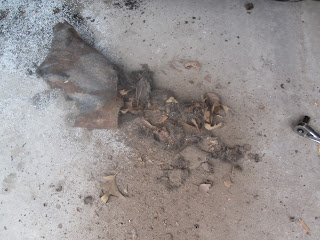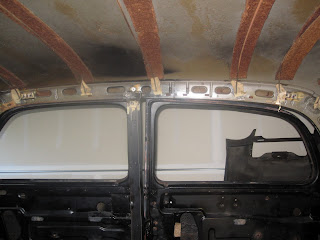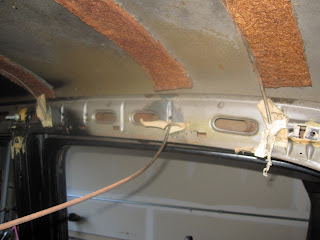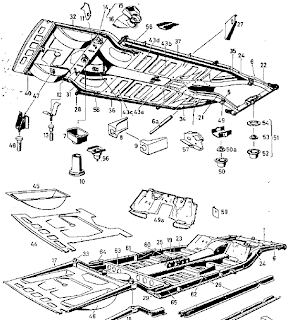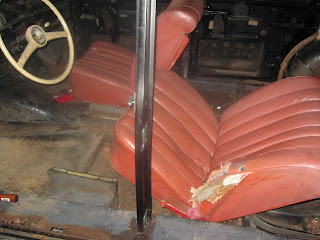While removing the front panel, I managed to dislodge some more dirt out of the ventilator air scoops, so I figured while I'm in the neighborhood... let's get these cleaned out.
A photo up inside the driver's side scoop. Dirt, leaves, and the remains of the liner.
First task is to remove the insect screens at the rearward ends of the air scoops. They're held in place with wingnuts. They refuse to budge until I get a pair of pliers out and give them a twist. One comes out easy - the other, sadly, snaps off. I'll have to drill the remains out.
And out it comes. And now the sheer amount of crap that has accumulated in the scoop is more evident.
Insect screen. Aside from a small hole in the middle, it appears to be in good shape. The passenger side screen is a bit better off.
Once the screens are out, it's easier to push the detritus out from the rear end of the scoop, and to pull the old liner material away where it's still glued. This is the pile of crap that was in the driver's side scoop.
The passenger side scoop is equally occupied.
Fortunately, the liner material in the passenger side scoop came away largely intact - I'm holding onto it so I can use it as a pattern later to fashion liners from new material.
The insect screens also had some strips of simliar material glued on each side where it meets the scoop - padding to prevent vibration and noise, I figure. Also holding onto a set of these to use as patterns later.
Monday, October 25, 2010
Front panel and bumper mounts removal
Next up is to remove some bits from the front end - the front panel, and bumper mounts.
The front panel is the body part pictured above, that runs between the two front fenders and beneath the grille. The front bumper mounts poke out through the holes on either side.
The front panel is mounted to each fender with four bolts/nuts (which are a huge pain to remove if you don't have the car up on a lift, due to tight quarters). Another bolt on each side passes through the shell and is held with a nut held down by a clip (seen just above and to the left of the leftmost of the four bolts pictured). These clips, naturally, gave up the ghost and began letting the square nut spin - so they had to go, and vice grips attached to hold that nut steady as the bolt was removed.
One more bolt, right in the middle, needs to come off.
And then, a bit of wiggling (to loosen up the rubber seals between front panel and fenders) and the panel is free.
The seals between the front panel and the fenders. From the illustration in the old dealer parts book, I'm guessing these pieces originally came straight. I'm going to hold onto these seals, to use as patterns in case I need to use something different as a workable replacement.
The last bits to come off are these pieces, one on each side. I'm unsure at the moment what they're for - I'm guessing as supports for the front panel. I'm not finding them in the old parts book PDF where the front panel is listed.
Now I can easily remove the bumper mounts. Each one is held with a pair of 17mm bolts. These come loose with a sufficient application of penetrant and oomph.
Bumper mounts removed. Note the left one is missing the part pointing toward the bottom of the photo - this part broke away when I first removed the front bumper. And the right mount is bent in somewhat in about the same spot. I'm guessing at some point in the distant past, the bumper took a fairly good hit, and the mounts took a fair amount of the impact, bending in the process. I'm going to look into replacing both - the left mount out of necessity, the right out of caution.
The front panel is the body part pictured above, that runs between the two front fenders and beneath the grille. The front bumper mounts poke out through the holes on either side.
The front panel is mounted to each fender with four bolts/nuts (which are a huge pain to remove if you don't have the car up on a lift, due to tight quarters). Another bolt on each side passes through the shell and is held with a nut held down by a clip (seen just above and to the left of the leftmost of the four bolts pictured). These clips, naturally, gave up the ghost and began letting the square nut spin - so they had to go, and vice grips attached to hold that nut steady as the bolt was removed.
One more bolt, right in the middle, needs to come off.
And then, a bit of wiggling (to loosen up the rubber seals between front panel and fenders) and the panel is free.
The seals between the front panel and the fenders. From the illustration in the old dealer parts book, I'm guessing these pieces originally came straight. I'm going to hold onto these seals, to use as patterns in case I need to use something different as a workable replacement.
The last bits to come off are these pieces, one on each side. I'm unsure at the moment what they're for - I'm guessing as supports for the front panel. I'm not finding them in the old parts book PDF where the front panel is listed.
Now I can easily remove the bumper mounts. Each one is held with a pair of 17mm bolts. These come loose with a sufficient application of penetrant and oomph.
Bumper mounts removed. Note the left one is missing the part pointing toward the bottom of the photo - this part broke away when I first removed the front bumper. And the right mount is bent in somewhat in about the same spot. I'm guessing at some point in the distant past, the bumper took a fairly good hit, and the mounts took a fair amount of the impact, bending in the process. I'm going to look into replacing both - the left mount out of necessity, the right out of caution.
Fuel change-over cock/filter removal
Removing the fuel change-over cock is a fairly simple task. Just a matter of disconnecting a few feeds and a couple of bolts.
First thing is to detach the reserve switch post. This changes which fuel line the filter draws fromg. It's held on with a spring clip, much like the door latches were.
Next is to disconnect the fuel lines (surprisingly easy - they didn't require too much pushing) and the hose from the fuel filter to (what I believe is) the fuel feed pump, and then to remove the two bolts beneath the change-over cock that holds it to the body.
Fuel change-over cock removed. The old filter came out in a puff of orange residue. I think it's done.
Front windshield removal
Time to get on removing the remaining glass on the car - the front and rear windshields. First, the front windshield.
The rubber seal on the front windshield has been shot for years. It was so bad that leakage on the sides caused water damage on the main wood dashboard, and the two smaller wood pieces below that hold the vent levers, to the point that I picked up replacement parts from a fellow Pontoneer.
To get the windshield out, basically I just have to take a flathead screwdriver and pop the seal away in pieces. In the above photo you can see where the seal has cracked and separated in some places, and on the top left, where I've already snapped a part of it away. A few more minutes of attacking the formerly-rubber seal and the windshield comes free.
No more windshield.
The removed windshield, still with a fair bit of the seal remaining. Next task is to get the trim out in one piece.
The seal remnants are so brittle that it's just a matter of picking it off piece by piece.
Windshield and surrounding trim. The trim itself is in good shape, with the exception of a fairly large notch along the bottom, near the middle. I imagine this is thanks to a rock some years ago. If I can find a replacement piece for a good price, I may just replace it.
The rubber seal on the front windshield has been shot for years. It was so bad that leakage on the sides caused water damage on the main wood dashboard, and the two smaller wood pieces below that hold the vent levers, to the point that I picked up replacement parts from a fellow Pontoneer.
To get the windshield out, basically I just have to take a flathead screwdriver and pop the seal away in pieces. In the above photo you can see where the seal has cracked and separated in some places, and on the top left, where I've already snapped a part of it away. A few more minutes of attacking the formerly-rubber seal and the windshield comes free.
No more windshield.
The removed windshield, still with a fair bit of the seal remaining. Next task is to get the trim out in one piece.
The seal remnants are so brittle that it's just a matter of picking it off piece by piece.
Windshield and surrounding trim. The trim itself is in good shape, with the exception of a fairly large notch along the bottom, near the middle. I imagine this is thanks to a rock some years ago. If I can find a replacement piece for a good price, I may just replace it.
Sunday, October 10, 2010
Other updates
Lately I've connected with a couple more fellows on the Ponton list: Harry in California (mentioned a few posts earlier) and Jeff in Massachusetts.
Harry's got a '58 220S that he's willing to sell me some parts from. My plan right now is to buy several pieces from him:
* Both entrance sills (to cover the rusted out outer trim mount holes, and the driver's side rusted step area)
* A partial set of outer door/sill trim (that will, with the partial set I currently have, make a complete set)
* Both front fenders (the headlight areas on mine are both degraded, plus I have some body damage on the left fender - the headlight areas are more important)
The fun bit will be getting the fenders from Los Angeles to here in Denver. I'm pondering going the Craigslist route - they have a rideshare section, for people who are driving from X to Y, and looking for a passenger to help share costs - or folks looking to be a passenger. I may just post a note on there when the time comes, looking for someone heading this way who has spare cargo space to haul the fenders. The other options are have them shipped, or simply roadtrip down and pick them up. It's only a thousand miles each way...
Jeff is a fellow who recently posted on the Ponton list that he had found a scrap yard in his general vicinity (well, an hour away from him, he says) that has several old Pontons in varying condition. I've gotten the contact info of the yard owner from him, and will be contacting him this week. Jeff also mentioned another fellow he's met who has three Pontons he's looking to part out. I may have to inquire on this front as well.
Jeff was kind enough to travel to this yard and snap a lot of photos:
http://s947.photobucket.com/albums/ad313/plumbumponton/Ponton%20Parts%20Cars/?action=view¤t=a2d41237.pbw
From these cars, I'm hoping to acquire a few goodies: the tail lights off the baby blue car (photo #10) and a steering wheel off either of two cars (photos #53, or #40). I'm also hoping to snag a full set (off various cars) of intact door lock posts - ones that still have the black rounded bakelite caps in place. My posts in OK shape, but missing those caps. I know, cosmetic, but it's one of those things, y'know?
Harry's got a '58 220S that he's willing to sell me some parts from. My plan right now is to buy several pieces from him:
* Both entrance sills (to cover the rusted out outer trim mount holes, and the driver's side rusted step area)
* A partial set of outer door/sill trim (that will, with the partial set I currently have, make a complete set)
* Both front fenders (the headlight areas on mine are both degraded, plus I have some body damage on the left fender - the headlight areas are more important)
The fun bit will be getting the fenders from Los Angeles to here in Denver. I'm pondering going the Craigslist route - they have a rideshare section, for people who are driving from X to Y, and looking for a passenger to help share costs - or folks looking to be a passenger. I may just post a note on there when the time comes, looking for someone heading this way who has spare cargo space to haul the fenders. The other options are have them shipped, or simply roadtrip down and pick them up. It's only a thousand miles each way...
Jeff is a fellow who recently posted on the Ponton list that he had found a scrap yard in his general vicinity (well, an hour away from him, he says) that has several old Pontons in varying condition. I've gotten the contact info of the yard owner from him, and will be contacting him this week. Jeff also mentioned another fellow he's met who has three Pontons he's looking to part out. I may have to inquire on this front as well.
Jeff was kind enough to travel to this yard and snap a lot of photos:
http://s947.photobucket.com/albums/ad313/plumbumponton/Ponton%20Parts%20Cars/?action=view¤t=a2d41237.pbw
From these cars, I'm hoping to acquire a few goodies: the tail lights off the baby blue car (photo #10) and a steering wheel off either of two cars (photos #53, or #40). I'm also hoping to snag a full set (off various cars) of intact door lock posts - ones that still have the black rounded bakelite caps in place. My posts in OK shape, but missing those caps. I know, cosmetic, but it's one of those things, y'know?
Headliner mounting rails/bows removal
As time has progressed over these past few months, every now and again I would grab at some random scrap of headliner that was hanging down and just tear that sucker out. The headliner has been toast on this car for decades. Now it's time to get the rest of it all out.
First up are the mounting rails that run along above where the doors fit.
Each side has four rails of varying shapes/sizes, held down with screws. Most of these come out easily, but a couple at the rear end, caked with glue from the previous headliner, are a bit tougher to extract.
Passenger side headliner mounting rails, laid out in order.
Now that those rails are removed, I should be able to get the center mounting posts of the grip rails out as well (located just above the pillars).
Next task is to remove the metal bows that run across the top of the passenger compartment.
There are seven of these bows across the top of the compartment. As best I can tell from reading some related webpages, the headliner should have sleeves that these bows slide through to hold it in place. Those sleeves are like the sleeves in camping tents, that the collapsable supports are slid into and out the other side, I'm guessing.
Here's an article on the Ponton site that will no doubt come in handy when the time comes to install a new headliner:
http://www.mbzponton.org/valueadded/maintenance/headlnr.htm
I don't know if it's just age or what, but I can't get a good purchase on these bows to pull one end out - so I end up rotating them downward, and then one end pops out easily.
All seven bows out, and the more solid remains of the padding strips are out.
First up are the mounting rails that run along above where the doors fit.
Each side has four rails of varying shapes/sizes, held down with screws. Most of these come out easily, but a couple at the rear end, caked with glue from the previous headliner, are a bit tougher to extract.
Passenger side headliner mounting rails, laid out in order.
Now that those rails are removed, I should be able to get the center mounting posts of the grip rails out as well (located just above the pillars).
Next task is to remove the metal bows that run across the top of the passenger compartment.
There are seven of these bows across the top of the compartment. As best I can tell from reading some related webpages, the headliner should have sleeves that these bows slide through to hold it in place. Those sleeves are like the sleeves in camping tents, that the collapsable supports are slid into and out the other side, I'm guessing.
Here's an article on the Ponton site that will no doubt come in handy when the time comes to install a new headliner:
http://www.mbzponton.org/valueadded/maintenance/headlnr.htm
I don't know if it's just age or what, but I can't get a good purchase on these bows to pull one end out - so I end up rotating them downward, and then one end pops out easily.
All seven bows out, and the more solid remains of the padding strips are out.
Old nasty antisqueak lining removal
Now comes the dirty, nasty task of cleaning out the old antisqueak lining in the passenger compartment.
First thing is to pull out the pieces that are in the floorboard area. A couple of screws toward the rear (which were underneath the seats) frees them up. There were screws on the other end that I had pulled out some time back. The nature of all these screws makes me think they were what mainly held the carpet down, back when there *was* carpet.
What a mess! This stuff has degraded to the point that it's almost soil-like in some places.
It's at this point that I begin discovering some more rust, in the corners at the front of the floorboard area. In this photo, the flash of the camera obscures the light coming in from beneath the car.
Here's a non-flash photo of the passenger side floorboard. The rusted out area is clearly visible. The driver's side is in similar condition.
It's at this point that I posted on the Ponton group, asking about my options on this area, and that Harry got in touch. Tom from the Mercedes Benz Classic Center in California also chimed in to say that they still have factory floorpans available. My front floorpans are kinda rusty, and I may consider getting some new pieces to go in - but this rust appears to be more on the toeboard, which is one piece that spans the width of the car, covering both front seat areas. I'll be emailing Tom and inquiring as to the availability (and pricing, gah!) of these parts soon.
Here's a snap from the old parts book PDF I got ahold of last year. The toeboard is the piece nearly dead center, labeled 49a. I may need a pair of floor pieces as well (top part, labeled 43a & 43b). I'm hoping I can get away with just the toeboard, if need be - it'll largely depend on costs (new piece vs. labor to patch).
Rear passenger floorboard area. The frame to the right is what the rear seat bench sits on.
Last of the floor areas, underneath the rear seat.
Time to get scrapin'. At first I started with a flathead screwdriver, and then found an chisel scraper I had laying around, at which point things progressed much quicker. Here I'm starting to remove the lining from the toeboard.
Underneath the driver's side toeboard lining, I discover a rubber piece that fit between the toeboard and the headlight foot switch. Into the correct baggie with this piece - it looks to be in good, reusable shape.
Lining removal is progressing. Next is to peel away the thicker lining over the transmission cover.
Bit by bit, this stuff comes away. In this photo, you can better see the wiring that is clipped onto the left side of the transmission cover, that snakes back to eventually pass through to the trunk compartment, to power the tail lights.
Front floorboard all de-lined. Lots of surface rust.
Rear area beneath seat area. Several grocery baggies worth of lining scraps are collected and trashed, and a shopvac does the rest.
First thing is to pull out the pieces that are in the floorboard area. A couple of screws toward the rear (which were underneath the seats) frees them up. There were screws on the other end that I had pulled out some time back. The nature of all these screws makes me think they were what mainly held the carpet down, back when there *was* carpet.
What a mess! This stuff has degraded to the point that it's almost soil-like in some places.
It's at this point that I begin discovering some more rust, in the corners at the front of the floorboard area. In this photo, the flash of the camera obscures the light coming in from beneath the car.
Here's a non-flash photo of the passenger side floorboard. The rusted out area is clearly visible. The driver's side is in similar condition.
It's at this point that I posted on the Ponton group, asking about my options on this area, and that Harry got in touch. Tom from the Mercedes Benz Classic Center in California also chimed in to say that they still have factory floorpans available. My front floorpans are kinda rusty, and I may consider getting some new pieces to go in - but this rust appears to be more on the toeboard, which is one piece that spans the width of the car, covering both front seat areas. I'll be emailing Tom and inquiring as to the availability (and pricing, gah!) of these parts soon.
Here's a snap from the old parts book PDF I got ahold of last year. The toeboard is the piece nearly dead center, labeled 49a. I may need a pair of floor pieces as well (top part, labeled 43a & 43b). I'm hoping I can get away with just the toeboard, if need be - it'll largely depend on costs (new piece vs. labor to patch).
Rear passenger floorboard area. The frame to the right is what the rear seat bench sits on.
Last of the floor areas, underneath the rear seat.
Time to get scrapin'. At first I started with a flathead screwdriver, and then found an chisel scraper I had laying around, at which point things progressed much quicker. Here I'm starting to remove the lining from the toeboard.
Underneath the driver's side toeboard lining, I discover a rubber piece that fit between the toeboard and the headlight foot switch. Into the correct baggie with this piece - it looks to be in good, reusable shape.
Lining removal is progressing. Next is to peel away the thicker lining over the transmission cover.
Bit by bit, this stuff comes away. In this photo, you can better see the wiring that is clipped onto the left side of the transmission cover, that snakes back to eventually pass through to the trunk compartment, to power the tail lights.
Front floorboard all de-lined. Lots of surface rust.
Rear area beneath seat area. Several grocery baggies worth of lining scraps are collected and trashed, and a shopvac does the rest.
More trim removal (beneath rear windshield)
Since removing the rear seat, I began tearing at more of the sad remains of the headliner. It's at that point that I began to see the way the trim that wraps around the back of the car top is mounted.
These pieces of trim (three all told) are held down with the same sorts of hardware that the slender moulding on the doors is attached - with metal/rubber washers held down with a nut. There's close to a dozen of these spread out across the back of the compartment. Some are easy to remove - others are in very tight, annoying spaces. I end up borrowing a couple of socket attachments, including a flexible one, to have any hope in getting some of those nuts off.
Now it's a matter of tugging the trim away gently. It's been in place for 52 years so it doesn't budge right away, but a bit of pushing on the posts from behind helps.
The trim is in three pieces - two smaller pieces on each end. Here's one piece seperated. They're held together with one of the mounting pieces, which has an extra-wide rectangular backing that both trim pieces slide onto.
Done!
One door off, and front/rear seat and seat rail removal
Well, that's one. :)
The bolts holding the door hinges to the body are pretty well stuck. Not long ago, I ordered a couple of cans of Kroil from the manufacturer - they had a deal where you get one free can with an order, so I just ordered one can and ended up with two. Not a bad deal. And this stuff seems to work a bit better than the Deep Creep. I've been hitting the hinge areas with this stuff now and again, and then occasionally giving the bolts a try with the screwdriver/wrench combo. Amazingly, the left rear door bolts at the bottom all came loose with a minimum of fuss - and since the top hinge bolts were all loose from before, I was good to go.
Next up is removing the seats. The service manual CDs have pretty light (and wrong, I'm finding - more on that later) instructions on removing the seats. First up is the back seat.
First step is to loosen the bottom of the seat, by simply pushing downward on the front edge; the whole seat slides free of the back part.
Bottom part of seat is now free.
Out it comes!
Now to remove the back part.
The service manual says to free up a pair of bolts from inside the trunk compartment. It doesn't really say *where* these bolts are, though. At first I try these, along the bottom of the trunk area...
...but no - it's the pair at the top of the trunk area.
Then it's a matter of pulling the back of the seat forward a bit, so those posts come free of the body - and then lifting the whole piece upwards, to free it from a pair of metal tabs.
A better shot of the metal tabs and the spots on the seat back that they slide into.
And those two bolts at the bottom of the trunk compartment? They're for a pair of seat adjustors - once the seat backing is in place, these are threaded back out from the rear (the ends of the bolts have a slot for a flathead screwdriver), to push up against the seat back to help prevent vibration.
Now the front seats.
The service manual instructions for removal say to slide the front seats forward and off the rails - but this doesn't work! The bulge for the transmission prevents the seats from moving that far forward.
A little searching on the Ponton mailing list archives yields some results - someone else had issues with this just a few weeks back, in fact. The solution is to remove the stops on each seat mount, and slide the seats off the back ends of the rails. The stops are on the outsides of each seat, held by a pair of Phillips head bolts. Easy enough to remove (aside from the bodily contortions) and the seats slide right off.
All the seats are out!
Now to remove the rails. Each rail is held on with four bolts. A bit of penetrant on these helps a lot.
The passenger side seat rails have some leaf springs the driver's side doesn't have - these are apparently to help prevent vibration and noise for when there is no passenger. As the driver's seat always has someone in it, they're not needed on those rails.
The last task is to remove the clips for the rail mount bolts. These take a bit of wrestling to get out, as they want to hang on the other end of the rectangular openings as they're removed. Just have to pull back and up at the same time.
Subscribe to:
Comments (Atom)




